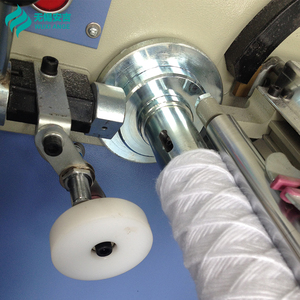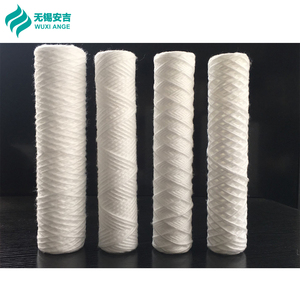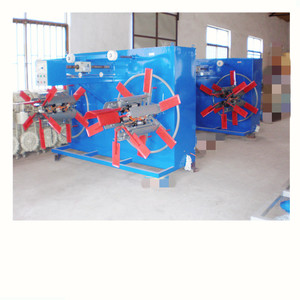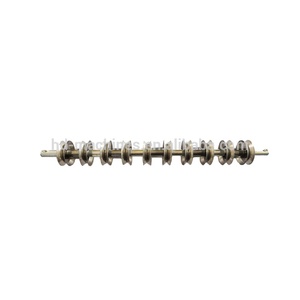
All categories
Featured selections
Trade Assurance
Buyer Central
Help Center
Get the app
Become a supplier

(363 products available)

























There are several categories of PP yarn filter winding machines based on construction, mechanism, motor, control system, and applications.
Based on construction
PP filter winding machines can be horizontal or vertical, referring to how the winder is placed. Herringbone, on the other hand, is a vertical machine with an H-shaped shaft. Compared to horizontal machines, vertical filter PP yarn winding machines occupy less floor space but are generally taller. Horizontal machines are more common than vertical. The herringbone machines allow for more diverse filter patterns.
Based on mechanism
There are automatic and semi-automatic PP yarn filter winding machines. The latter requires human assistance to thread the yarn into the winder and occasionally cut the filter. Automatic machines can also wind different types of yarn without changing the setup.
Based on motor
PP filter yarn winding machines can be AC or DC motor winding machines. AC motor machines have simple operation, low maintenance, and high-speed winding. They have a fixed speed that matches the power supply frequency. Depending on the filter specs, customers may need to change the filter yarn winding speed. In this case, they will have to choose a DC motor machine. DC motor PP winding machines have greater control over the speed and can run at variable speeds, offering higher precision wounding. The downside is higher maintenance costs.
Based on control system
Machines can either be digital or traditional. Traditional models have a switch to control the speed, while digital models come with a digital panel to control multiple parameters.
Based on application
The main application of PP yarn is to make string filters for oil filters, air filters, and other types of filters. The latter two usually have two or more winding heads and are made to create multiple yarn filters at the same time.
PP yarn winding machine for filter is designed with several key specifications that are important for its effective operation and maintenance.
Construction material:
These machines are manufactured from highly durable metals such as cast iron or aluminum alloy. Such sturdy construction materials ensure that the filter yarns do not move or vibrate as they are being wound. Additionally, they provide intrinsic stability to the device, which helps achieve accurate and precise winding.
Control system:
PP yarn filter winding machines usually have easy-to-use electronic or mechanical control systems. Electronic control systems employ digital sensors and microprocessors to precisely regulate aspects like speed and tension. On the other hand, the machine uses gears and levers to manually set winding parameters when using a mechanical control system. Both systems have an easy-to-monitor interface that allows operators to adjust filter specifications according to their needs.
Filter holder:
This component of the yarn winder machine is designed to hold the filter securely as the yarn is wound around it. The filter holder provides the necessary support and shape to the filter. Depending on the machine model, it may have adjustable clamps, braces, or mandrels to accommodate different filter sizes and shapes.
Winding speed:
Winding speed indicates how fast the yarn is wound around the filter on the machine. It is measured in meters per minute or revolutions per minute. Speed settings on PP yarn winding machines can be adjusted to meet different production requirements. High-speed winding improves filtering production efficiency. However, too high a filtering production efficiency may compromise the quality of the filter if the yarn tension is not controlled properly.
Power supply:
The winding machine for PP yarn filters uses electricity as its main power source. The voltage and frequency requirements for perfect machine operation are specified. The specifications ensure that the machine receives the required power output for smooth operation and high-performance filtering.
Appropriate maintenance of the PP filter winding machine is required to ensure its longevity and continuous high performance. Regular maintenance can prevent breakdown, reduce repair costs, and keep filters of the highest standards for end users. Below are some maintenance tips for the winding machine:
Using a polypropylene (PP) yarn filter winding machine, several industries can produce filters of all shapes, sizes, and functions. Some of the common applications of filter-winding machines are as follows.
Industrial and chemical filtration:
Machines that wind yarn for producing filter cartridges are often used for chemical or industrial filtration. Wound cartridges are made for processing plants, chemical factories, or water treatment plants. These yarn filters capture specific chemical compounds, solid material, or toxic substances during the filtration process.
Liquid filtration in oil and gas excavations:
In the oil and gas industry, precise filtration is necessary to separate solid impurities from liquids. High-quality filters are made using HEPA filter winding machines to achieve optimum filtration. Liquid filters are made for use in upstream oil and gas exploration areas or refineries and petrochemical plants. Filters made with a winding machine collect solid particles from oil, gas, or water to prevent machinery from being damaged.
Agricultural irrigation filtration:
In the agriculture industry, yarn filter cartridges are also used. Automated winding machines can be used to produce these yarn filters. In irrigation projects, farmers make use of yarn filters at the pump outlet to protect the irrigation system from clogging. The filters prevent sand, sediment, and other solid particles from entering the tubes and sprinkler heads.
Heater and air conditioner air filtration:
An air filter is also produced by a yarn winding machine. Air filters are used in air conditioners, cooling systems, and HVAC systems. The cartridge or filter mesh catches dust, mold, pollen, bacteria, and other airborne contaminants to provide people with clean indoor air.
Production capacity:
When selecting a polypropylene yarn filter winding machine, it is important to assess the production capacity. This is the amount of yarn filters the device can produce in a certain interval, usually outlined as filters per hour or per day. It's crucial to verify that the machine's production capacity corresponds to the intended production volume. This ensures that the company will meet its supply requirements without encountering delays in the manufacturing process.
Quality:
Additionally, when choosing a winding machine, it's important to consider both the machine's construction quality and the final product it produces. Opt for machines made with high-quality materials that are built to last. Those with a solid construction will have better durability and require less maintenance over time. Ensure the winding machine can produce filters of consistent quality, too. Filters with uniformity, reliability, and effective filtration capabilities are essential for customer satisfaction and market competitiveness.
Size:
Another important factor to take into account is the range of sizes the winding machine can handle. Filters come in different sizes depending on their application, so it's essential to choose a machine that can wind the size of yarn required for various filter dimensions. It would also be beneficial if the machine could wind other types of yarn, like nylon or polyester, to provide more flexibility and accommodate future production needs.
Automation:
Automation level is an important consideration when selecting a filter winding machine. Automated machines typically incorporate advanced features such as programmable controls and automatic feeding systems, which can simplify operation and enhance production efficiency. The implementation of these automated processes is likely to reduce production time and costs, thus contributing to the overall profitability of the business.
Cost:
Finally, it's important to evaluate both the initial cost of purchasing the winding machine and the long-term operating expenses. While the upfront investment is significant, buyers should also consider factors such as energy consumption, maintenance requirements, and any additional expenses related to automation or specialized features.
Q: What is the working principle of an automatic pp filter making machine?
A: The working principle involves the following steps: material extrusion, the workpiece winding process, cooling/curing, cutting, and packing. The machine's automatic controller or program can control the parameters and replace manual operation.
Q: What are the benefits of using a pp yarn winding machine for filters?
A: A filter yarn winding machine increases production efficiency. It also produces high-quality filters with consistent quality. Moreover, it minimizes manual labor and offers cost-effective production in the long run.
Q: Can a pp yarn filter winding machine be upgraded for automatic operation?
A: Yes, it is possible to upgrade some models of the machines for automatic operation. Upgrading may involve adding an automatic controller, a cutting module, or a different type of feeding mechanism.
Q: What are the maintenance requirements for a pp yarn filter winding machine?
A: The maintenance requirements are routine inspection and cleaning. The machine will also need periodic lubrication and occasional replacement of worn parts. Manufacturers of these machines will provide the maintenance requirements manual.